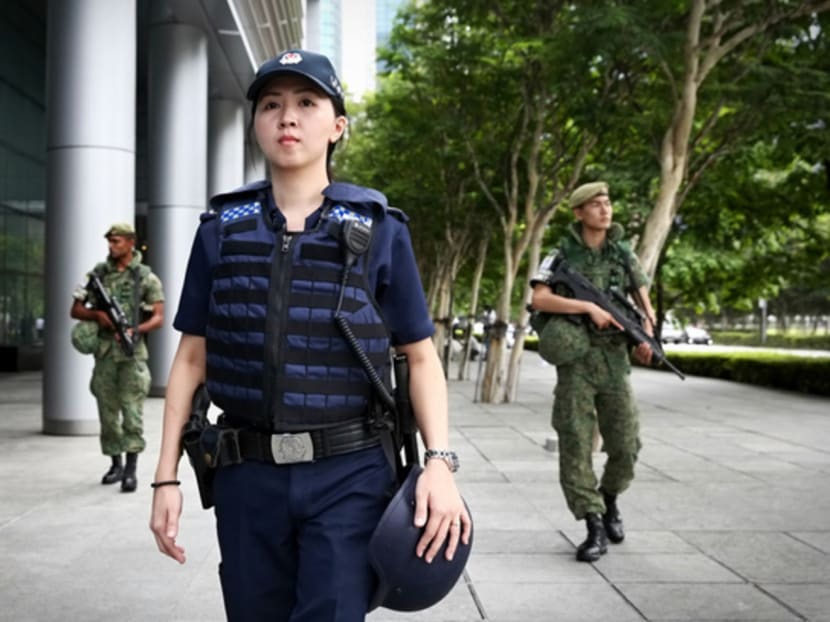Security at Boat Quay, other public areas could be beefed up
SINGAPORE — Amid the spate of overseas terrorist attacks involving vehicles driven into crowds, the Ministry of Home Affairs (MHA) has been engaging bollard suppliers and other industry players on the possibility of beefing up the security infrastructure of public spaces where crowds gather, TODAY understands.

A Joint Security patrol carried out along Marina Bay Financial Centre by SPF's Ground Response Force (GRF) and SAF's Island Defence Task Force. Photo: Nuria Ling/TODAY
SINGAPORE — Amid the spate of overseas terrorist attacks involving vehicles driven into crowds, the Ministry of Home Affairs (MHA) has been engaging bollard suppliers and other industry players on the possibility of beefing up the security infrastructure of public spaces where crowds gather, TODAY understands.
These areas could include Boat Quay, Clarke Quay and the Speakers’ Corner, for example. Members of Parliament (MPs), security consultants and experts TODAY spoke to agreed with the need to enhance the safety of such places, by installing bollards, having security patrols and closed-circuit television cameras, among other measures.
Nevertheless, an MHA spokesperson — in response to TODAY’s queries — did not comment on its specific plans in this regard, but said the ministry “will continue to monitor developments closely and calibrate our security measures accordingly”. She said: “Protection against attacks using everyday items such as vehicles and knives remains a challenge. As attacks around the world have shown, it is not possible for the security agencies to completely prevent such attacks. A balance must be struck, without turning Singapore into a fortress.”
In the past year alone, there have been several high-profile terrorist attacks where vehicles were driven into members of the public. Most recently, three men last week rammed a van into pedestrians on London Bridge and later stabbed people in the bustling Borough Market area.
Bollard suppliers and security consultants told TODAY that anti-crash bollards — which can withstand crashes by trucks weighing up to five tonnes — can help to counter vehicle-borne attacks. Such attacks have become the modus operandi especially in countries where extremists do not have access to firearms and explosives, said Dr Rohan Gunaratna, head of S Rajaratnam School of International Studies’ (RSIS) International Centre for Political Violence and Terrorism Research.
Recently, the Government amended the Public Order Act. The wide-ranging changes include possibly requiring organisers of large-scale public events — deemed to be at high risk of a terrorist attack or public order incident — to deploy armed security officers and barricades, and conduct full-person and bag checks.
A new Infrastructure Protection Act is also slated to be introduced later this year, under which “selected new, large-scale developments” are required to incorporate security measures during their design phase, the MHA spokesperson said.
While the MPs and experts felt that these measures are robust, they noted that vulnerabilities still exist in places which are accessible to crowds.
“Places where large crowds are gathered need to have enhanced security as previous events have shown that even the most innocuous of items like vehicles can be used as a weapon,” said Marine Parade GRC MP Edwin Tong, the vice-chair of the Government Parliamentary Committee (GPC) for Home Affairs and Law.
RSIS research fellow Graham Ong-Webb reiterated that such public spaces were “high-value targets for terrorists” because the large crowds comprise people of different backgrounds and nationalities. “Because places like Clarke Quay and Boat Quay are meant to attract large crowds, they are obliged to facilitate the easy flow of human traffic going into and out of these places. This increases vulnerability,” he said. Furthermore, these areas are in the heart of the Central Business District and tourist hotspots, said Dr Ong-Webb.
However, security consultant Toby Koh of Ademco Security said the authorities could face constraints in terms of budget. For example, the cost of installing one bollard ranges from S$3,000 to more than S$6,000. “It will be a long, expensive plan to beef up security measures everywhere,” he said.
Tampines GRC MP Desmond Choo, who also sits on the GPC, stressed that it was “not feasible to provide security coverage for every open spaces”. Adding that the authorities will explore all measures, including relying on intelligence and deploying patrol officers, he said: “But keeping Singapore safe is the added responsibility of all Singaporeans. This means keeping a sharper lookout for suspicious objects or individuals, with families and friends playing a role in reporting self-radicalised individuals to the authorities.”






